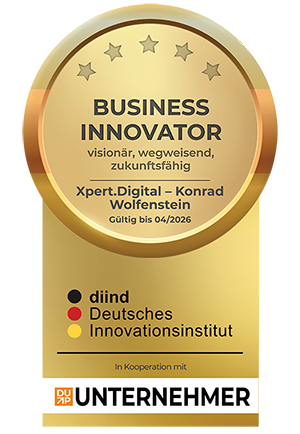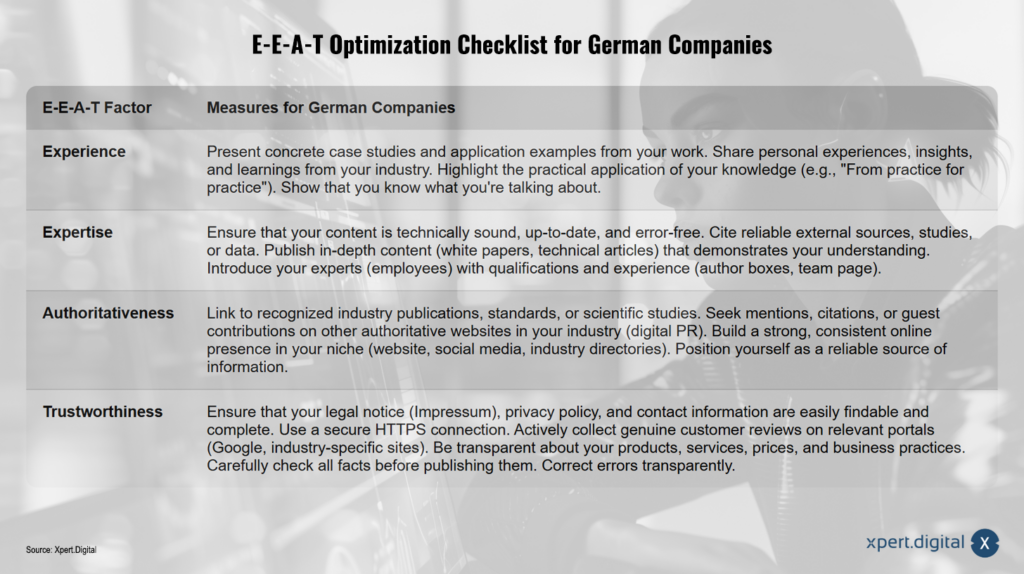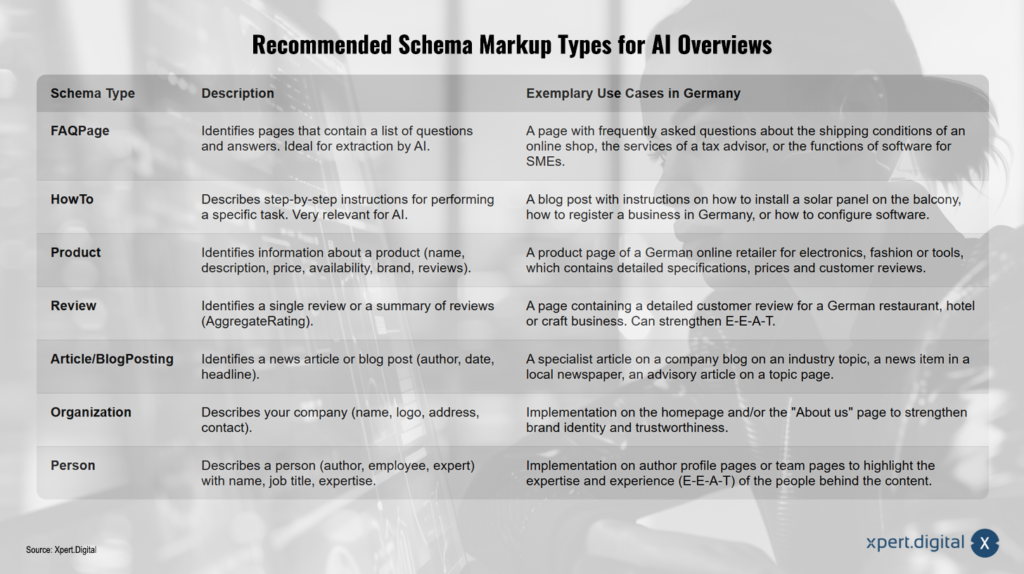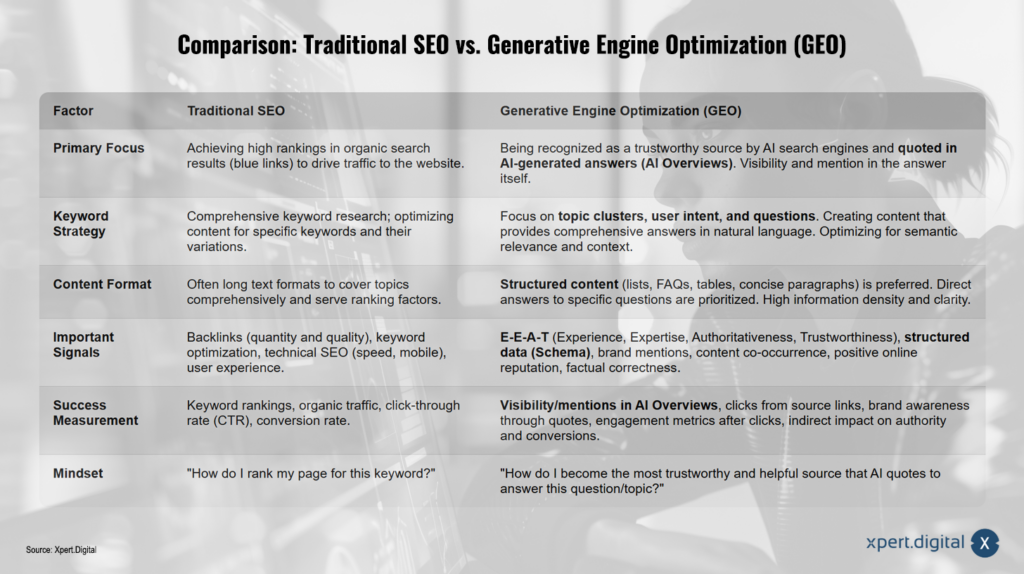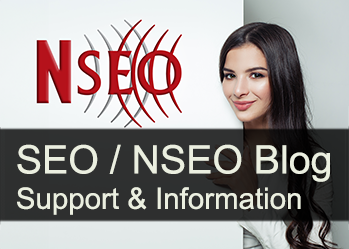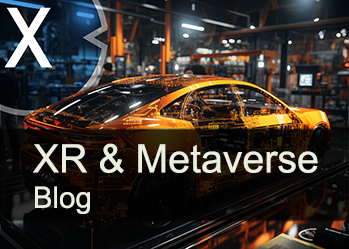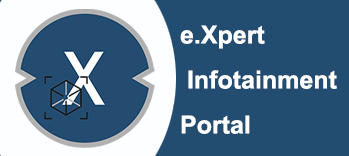The revolution of Google search in Germany: Effects of the AI update of March 26, 2025 and strategies for companies
Xpert pre-release
Language selection 📢
Published on: March 26, 2025 / update from: March 26, 2025 - Author: Konrad Wolfenstein

The revolution of Google search in Germany: Effects of the AI update of March 26, 2025 and strategies for companies-Image: Xpert.digital
AI-supported search: What German companies need to know now (reading time: 33 min / no advertising / no paywall)
Summary for decision -makers: a new age of information finding
March 26, 2025 marks a turning point in the history of digital search for information in Germany. Overnight, Google carried out a profound update that is fundamentally changed the way users find information on the Internet and how companies become visible. At the center of this revolution are AI-generated answers, often referred to as “AI overviews” or in experimental “AI Mode”. These intelligent summaries, which appear directly at the beginning of the search result, are increasingly taking the place of classic blue links to organic search results.
This development in particular presents small and medium -sized companies (SMEs) and service providers in Germany in front of immense challenges. Their visibility and the resulting valuable organic traffic, often the backbone of your online customer acquisition, now depend significantly on whether your content and offers are mentioned in these prominent AI overviews. The game rules of search engine optimization (SEO) are rewritten. The traditional focus on link-based ranking factors and exact keyword agreement gives way to a new priority: the optimization of content especially for the selection by Google's AI systems.
The criteria of experience, expertise, authority and trustworthiness - summarized in acronym EEAT (experience, expertise, authoritativeness, trusting) are now more important for this selection. Structured data that makes it easier for the AI to understand and contextualize content are also massive.
This report provides a comprehensive analysis of the profound effects of these changes on the German corporate landscape. It illuminates the mechanisms behind the new AI functions, identifies potential winners and losers of this change and, above all, offers concrete, implementable strategies. The aim is to provide companies, especially SMEs and service providers, the necessary knowledge and tools in order not only to assert themselves in this new reality, but also to secure their online presence and ideally even to strengthen. It is a call for rethinking and proactive adaptation to the new age of AI-supported search.
Suitable for:
- Google Ai Overviews-Google Search changes: “Google Google for you”-that is behind the new AI overviews
The transformation of Google search in Germany: AI focus
The move in of Ai Overviews and AI Mode: a strategic step
Around March 26, 2025, the so-called AI overviews in German Google search took place, which confirmed earlier observations and speculation. This step was part of a global strategy of Google, AI-based summaries to establish an integral part of the search results after they had already been rolled out in over a hundred other countries. Even before the official start, there were test phases in Germany in which selected users received these new overviews. This indicates careful preparation and gradually used to the new format.
At the same time, Google started the introduction of an experimental “AI Mode”. This mode, based on the advanced language model Gemini 2.0, promises extended skills in logical thinking, the processing of various types of information (multimodality) and even more extensive answers in the generation. Initially, access to this experimental mode was limited to paying subscribers from Google One Ai Premium, but was later also open to users who had registered on a waiting list. This staggered introduction, starting with paying customers, could be an indication that Google could possibly offer extended AI search functions behind payment barriers in the future. This would have far -reaching consequences for the accessibility of information and the competition in the search engine market.
An interesting technical innovation in AI Mode is the “query fan-out” technique. In the background, a single user request triggers several related search queries on sub -topics and different data sources. The results of these parallels are then synthesized by the AI in order to generate the most comprehensive and nuanced answer.
In the larger European context, the “European Search Perspective” (EUSP) initiative of search engines such as Ecosia and Qwant is also worth mentioning. Although it is not directly related to Google's update, it reflects a growing awareness and the desire for more digital sovereignty in Europe and could be an alternative to the dominant US search technologies in the long term.
The speed with which Google rolled out the AI overviews and at the same time tested AI Mode underlines the strategic determination of the group to redesign the search towards a AI-centered experience. For companies in Germany, this means that adaptability is not an option, but a necessity, since these AI functions are likely to play a more and more central role.
The presentation of the AI answers: How Ai Overviews work
Ai overviews appear as concise summaries, often formatted in blocks or lists, at the top of the Google search results (SERP-Search Engine Results Page). Their declared goal is to provide users a direct answer to their question as quickly as possible without having to click through several websites. They are displayed before the traditional organic search results and, depending on the complexity of the request and scope of the answer, they can take a significant part of the visible screen area.
Analyzes show that the average length of an AI overview is around 157 words, with the overwhelming majority (approx. 99%) remaining below 328 words. This underlines the focus on brevity and concise. In order to clearly present the information, the AI often fells back to formatting such as list signs (in around 61% of cases) and numbered lists (in about 12% of cases) as well as short, easily digestible text settings.
In some cases, Google also offers users the opportunity to adapt the representation of the AI overviews, for example by simplifying the language. This indicates a development towards more personalized and low -cash information.
An important feature of the AI overviews are the links to the source websites, from which the information for the summary has been extracted. These links offer users the opportunity to step into the topic deeper and consult the original sources. However, it is crucial to understand that the AI does not take over the answer from a single source, but synthesize information from various online sources.
The prominent placement and the often sufficient information offer of the AI Overviews have a significant consequence: the number of clicks on the traditional organic search results below could decrease noticeably. Users may already find their answer in the overview and no longer see any reason to visit a single website. This leads to an increase in the so-called “Zero-Click Searches” and requires companies to redefine their success metrics in online marketing, which goes beyond pure ranking positions.
The frequent use of lists and short paragraphs in AI overviews suggests that content that is already well structured, clearly formulated and optimized for quick recording have a higher chance of extracting and prominent from the AI. Companies should therefore prepare their content accordingly: structured, easy to read and with direct answers to potential user questions.
Although the links contained create transparency, there is a risk that it paradoxically leads to fewer clicks on the actual source if the summary is perceived as sufficient. At the same time, there is also a new opportunity for the cited websites: Visibility directly in the AI response and potential referral traffic of users who are looking for more detailed information and click on the source links. It is a new form of visibility that must be measured and evaluated differently.
Affected searches: where AI answers occur most frequently
Not all types of search queries are equally affected by AI Overviews. The AI summary of information-oriented search queries affects the strongest. These are inquiries where the user is looking for knowledge, would like to have answered a question or want to understand a topic (“How does photosynthesis work?”, “Symptoms of Flu”, “Best Time for Thailand”). Google seems to play AI overviews especially when the generative AI is considered particularly helpful to synthesize complex information or to illuminate various aspects of a question.
In contrast, navigation -oriented searches (users are looking for a specific website, e.g. Login Deutsche Bank ”,“ opening times Aldi ”) and transaction -oriented searches (users have a clear intention to buy, e.g.“ buy iphone 16 ”,“ cheap flights berlin to Munich ”) tend to be less directly from AI overviews. Here the user usually expects direct access to the target website or to concrete product offers.
However, this delimitation is not absolutely separable. There are observations that AI-based elements, such as product carousels within the AI Overview, can appear even with transaction-related searches. This could also affect the visibility of products and offers in this area and require new optimization approaches.
The interplay of AI OverViews with other elements on the search result is also interesting. They often appear together with boxes such as “similar questions” (People ASK) and sometimes also with featured snippets (highlighted text extracts). However, they less often occur in combination with classic product entries (shopping ads), local search results (local pack) or sitel links.
For companies, this means that those who primarily aim at information -oriented keywords in order to achieve users in an early phase of the customer journey (e.g. through advisory items, blog posts, explanatory videos) will feel the effects of the update most clearly. These companies have to massively align their content strategy to be present in the AI overviews.
Companies whose focus is on navigation or transaction keywords may be less affected at short notice. However, the development of AI elements for these addiction types also indicates that vigilance is offered. You should consider how your product, service and brand information can be optimally prepared in the future for a display in AI-supported search results. The interaction with “similar questions” and featured snippets also suggests that optimization for these more traditional SERP features could also indirectly increase the chances of being cited in AI overviews-an indication of synergy effects in modern SEO strategies.
Winner and loser in the new AI search ecosystem
Potential losers: SMEs and service providers with a traditional focus
The Google update does not hit all actors in the digital space alike. Small and medium -sized companies (SMEMS) and service providers are particularly affected, whose business models depend heavily on the visibility in the classic organic search results. Many of these companies have invested resources in SEO over the years in order to tend on relevant search terms in the front places and thus win website visitors and potential customers (leads).
The increasing presence of AI Overviews now questions this model. Since users find answers directly in the overview, the need to click on the links underneath. Estimates from the industry indicate that AI offers such as AI overviews could potentially lead to a loss of up to 25% of organic traffic. This increase in the “Zero-Click Searches” directly threatens the traditional channels of lead generation and customer acquisition of many German SMEs and service providers. They run the risk of losing a significant part of their valuable website visitors if they fail to be present in the AI Overviews or to open up alternative traffic sources.
For these companies, this means the need for a radical rethink. Previous SEO strategies, which may primarily focus on technical aspects, keyword density or the structure of backlinks, may no longer be sufficient. Adaptation to the new requirements of AI-supported search-in particular the focus on EEAT and high-quality, structured content-becomes a question of survival in the digital competition. The challenge is often also in limited resources and the know-how to implement these complex new requirements.
Suitable for:
- EEAT Marketing and PR: Is EEAT the solution of the future for search engine results and rankings because of AI development?
Table 1 of 3: Eeat optimization checklist for German companies
The EEAT optimization checklist for German companies offers valuable information on how you can specifically strengthen the experience, expertise, authority and trustworthiness of your brand. In order to promote the factor "experience", it is advisable to present specific case studies and application examples from your own work as well as to share personal experiences and industry -specific insights. Always show that your expertise is based on practical use - ideally based on the principle "from practice for practice". For a convincing "expertise", your content should be technically well -founded, up -to -date and flawless. Underline your knowledge by providing reliable sources such as studies or data and through profound publications such as white papers or specialist articles. Also present your experts and their qualifications prominently, for example via author boxes or the team page.
To increase the “authority”, the link to recognized industry publications, norms or scientific studies is recommended. Furthermore, you should actively strive for guest posts on other authoritarian websites or provide mentions in relevant channels, for example by digital PR. Your online presence in the respective niche should be expanded consistently and professionally-in addition to an appealing website, this also includes social media channels and entries in industry directories. Finally, create trust by ensuring that imprint, data protection declaration and contact information are easily accessible and complete. A safe HTTPS connection is as essential as the transparent presentation of products, services, prices and business practices. Real customer reviews on relevant portals as well as carefully checked, flawless and possibly corrected facts also contribute to the trustworthiness. Each of these aspects helps you to position yourself as a reliable source of information and influential player in your industry.
Potential winners: brands with strong Eeat signals and clear positioning
On the other side of the spectrum, there are also clear winners of the change. These are typically brands and companies that have put a strong focus on the establishment of expertise, authority and trustworthiness before the update. An exemplary example, which was mentioned in the original context, is the online presence of experts and specialized platforms such as Konrad Wolfenstein with its industrial hub Xpert.digital. Such actors, who are clearly positioned as a pioneer and reliable source of information in a specific niche (such as digitization, mechanical engineering, logistics), seem to be well equipped in order to also dominate in the AI-controlled search results.
The importance of EEAT (experience, expertise, authority, trustworthiness) for the presence in AI overviews is emphasized. Google's AI systems are trained to prefer content from sources that demonstrate these qualities. Companies that have been proven to have in -depth expertise (expertise), can share practical experience (experience), as recognized size in their industry (authority) and their information are classified as reliable and credible (trustworthiness), have a significantly higher chance of being used by AI as a source for the AI Overviews.
The example of Xpert.digital suggests that the establishment of a strong, trustworthy online brand and the establishment as an expert within a clearly defined niche are decisive. This not only includes the presence of specialist knowledge, but its active demonstration through high -quality, informative content (blog articles, studies, white paper), a professional and well -structured website, transparent author profiles and a consistent digital presence.
The success of such specialized and authoritarian sources could indicate a shift towards a more meritocratic search environment - at least in theory. Real expertise and verifiable authority are potentially rewarded more than pure SEO tricks. Paradoxically, this could also open up opportunities for smaller, highly specialized companies that Eeat can effectively demonstrate in their niche, even if they do not have large corporations. The focus of examples such as Xpert.digital on B2B industry also shows that the AI transformation has particularly relevant effects on how companies reach and convince their target groups online in specialized sectors.
Our recommendation: 🌍 Limitless reach 🔗 Networked 🌐 Multilingual 💪 Strong sales: 💡 Authentic with strategy 🚀 Innovation meets 🧠 Intuition
At a time when a company's digital presence determines its success, the challenge is how to make this presence authentic, individual and far-reaching. Xpert.Digital offers an innovative solution that positions itself as an intersection between an industry hub, a blog and a brand ambassador. It combines the advantages of communication and sales channels in a single platform and enables publication in 18 different languages. The cooperation with partner portals and the possibility of publishing articles on Google News and a press distribution list with around 8,000 journalists and readers maximize the reach and visibility of the content. This represents an essential factor in external sales & marketing (SMarketing).
More about it here:
Expert knowledge and trust: How Google evaluates content
The key role from EEAT in the age of AI search
Eeat decodes: more than just an acronym
Eeat is the central concept that leads Google's evaluation of content quality and trustworthiness and is now becoming even more important for visibility in AI overviews. The individual components mean in detail:
Experience
Refers to the extent to which the creator of the content has practical, first -hand experience with the dealt with. Has the author tested a product himself? Did the company go through a process itself? Was the author in a place he writes about? This practical perspective gives the content authenticity and credibility. The addition of the “E” for experience in 2022 to the original EAT framework underlines Google's growing interest in real world knowledge and personal insight.
Expertise (expertise)
This concerns the demonstrable expertise and the competence of the author or the website in the respective topic. Is the author a recognized specialist? Does the website have a history of high -quality content on this topic? Expertise is often demonstrated by qualifications, awards or the depth and accuracy of the information provided.
Authoritativeness
Describes the reputation and recognition that the author, the content and the website enjoy in your industry or niche as a whole. Is the website a frequently cited source? Is the author respected and mentioned by other experts? Authority often builds up over time and is strengthened by external signals such as links from other renowned pages, mentions in the press or positive reviews.
Trustworthiness
This may be the most important aspect. It includes the general credibility, honesty, security and reliability of the content, creator and the website. Are the information correct and fact -based? Are there clear contact information and an imprint? Is the website safe (https)? Are sources given transparently? The basis on which the other EEAT factors build up is trustworthiness.
Google itself repeatedly emphasizes that its ranking systems, including those that generate AI overviews, are designed to identify and reward original, high-quality content that demonstrate EEAT. This applies regardless of how the content was created-in principle also for AI generated content as long as you meet these quality criteria (which is often a challenge in practice). The consistent communication of Google's makes it clear: Eeat is not an abstract concept, but a fundamental guide for the algorithms. Companies must treat the structure and visible demonstration of these qualities as a strategic priority.
How Eeat influences the selection for AI Overviews
Strong EAT signals are the key to increase the likelihood that the own content of Google's AI recognizes as a trustworthy source, used in AI overviews and cited accordingly. The progressive fusion of artificial intelligence and the traditional search will further reinforce the importance of EEAT for digital visibility.
AI algorithms are dependent on evaluating the credibility and reliability of information sources in order to be able to provide users precise and helpful summaries. The AI serve as important indicators. In particular, the careful review of facts within the content, the clear presentation of the expertise and experience of the authors (e.g. through detailed author profiles with qualifications), the establishment of a strong brand reputation and positive mentions by other respected sources on the web significantly contribute to building EEAT. These factors directly improve the chances of being prominently placed in the coveted AI overviews.
The emphasis on the mention by respected sources also shows that traditional off-page-seo tactics, in particular those that aim to build up authority through high-quality, theme-relevant backlinks and positive branded mention are still relevant. In the context of the AI search, they could even gain in importance, since they serve as an external validation of the authority of a source. However, it is less about the pure number of links than their quality and thematic connection.
Suitable for:
Strategies for action: Optimize content for AI search
In order to be successful in the new era of AI supported search, companies have to adapt their content strategies. The following measures are crucial:
Prioritize structured content and direct answers
A consistent recommendation is: make it as easy as possible for the AI to understand your content and extract relevant information. This is best done by clear and logical structuring your content. Use meaningful headings (H1, H2, H3 etc.) to divides topics. Use list signs and numbered lists to clearly present information. Integrate question-answer sections (FAQs) that take up frequently asked user questions directly.
The focus should be on providing direct and concise answers to specific user questions. This approach, sometimes also referred to as “Micro SEO”, aims to provide exactly the information snacks that users (and thus also the AI) are looking for. The most important question should ideally be answered right at the beginning of a section. Complex topics should be divided into smaller, easily digestible sections.
Studies indicate that AI models prefer structured content and that they are referenced with a significantly higher probability in AI generated results-some sources speak of up to 50% more likely. Companies should therefore move away from long, unstructured text deserts and organize their information clearly, logically and for the reader (and the AI) easily. This not only improves the chances of being included in AI overviews, but also increases the general user -friendliness of your website.
Optimization for natural language (NLP) and user station
Modern search engines, especially the AI-based systems, rely on natural language processing (NLP) to understand the meaning and context of content and search queries. It is no longer sufficient to optimize content only on exact keyword agreement. Instead, companies have to learn to understand the natural language and the search habits of their target group and to design their content accordingly.
The focus must be on the user: What does the user really want to know or achieve if he asked a specific search query? Use a natural, sometimes colloquial wording that corresponds to the way people actually speak and search. Analyze which questions your target group about-tools such as Google Trends, the AutoComplete function of the search or specialized question research tools can provide valuable insights here.
Optimize not only for individual keywords, but for entire themed clusters. Create comprehensive content that illuminate a topic from different perspectives and answer related questions. A deep understanding of the search intention is crucial to create content that is classified as relevant and helpful by the AI. This approach requires a more demanding content creation that anticipates the needs of users and offers real added value.
Strengthen branding and cultivate content-ko-OKKUTRENT
The authority and trustworthiness of a brand not only evaluate from AI systems on the basis of their own website, but also through the presence and mention in the entire digital ecosystem. It is therefore advisable to build a strong and consistent digital presence on several relevant and respected platforms.
This includes strategic measures such as:
Content syndication
Publication of your content on other relevant platforms (with correct source).
Digital PR
Active press work and placing expert contributions or interviews in specialist media.
Strategic partnerships
Cooperation with other companies or influencers in their industry.
Community engagement
Presence and active participation in relevant online forums, industry groups and on social media platforms.
The aim is to create a “content KO-OKKUTIST”: Your brand and core competencies should often appear on the web in connection with the topics and keywords that are relevant to you. Identify the key topics of your industry and make sure that your brand is perceived as a relevant actor in this topic on various trustworthy online sources.
AI algorithms take this broader online picture into account when evaluating the authority. A strong, positive and thematically consistent presence on various channels signals the AI credibility and relevance, which increases the chances of being considered in AI overviews as a source of information.
The indispensable role of technology: structured data and SEO bases
In addition to high-quality content and strong EAT signals, the technical optimization of the website also plays a crucial role in visibility in AI search.
Scheme Markup: Speak the language of the AI
The implementation of structured data using a scheme markup is strongly recommended. Scheme Markup is a standardized vocabulary that you can add to your website code to provide search engines explicit information about the meaning and context of your content. It helps Google (and its AI) to better understand their page content, classify and extract information more precisely.
Particularly relevant schema types in the context of AI overviews are:
Faqpage
Recorded pages with a list of questions and answers. Ideal for FAQ areas, product or service sites.
Howto
Describes step-by-step instructions. Perfect for tutorials, instructions and advisory items.
Product
Defines information about a product (name, price, availability, reviews). Indispensable for e-commerce websites.
Review
Identifies individual ratings (e.g. from customers).
Article/blog posting
Helps to identify the main content of an article or blog post (heading, author, date).
Person/organization
Provides structured information about authors or the company itself, which can strengthen EEAT signals.
The implementation is preferably carried out in the JSON LD format, as this is often easier to use. Studies indicate that websites that use structured data have a significantly higher probability (some speak of up to 40% more) to be referenced in AI generated results. Scheme Markup is therefore no longer a pure optimization for Rich snippets, but a fundamental prerequisite for improving visibility in the AI-supported search landscape. You speak the preferred language of the AI.
Table 2 of 3: Recommended Scheme Markup types for AI overviews
The table lists recommended Schema Markup types for AI overviews. The type FAQPAGE identifies pages that contain questions and answers, such as frequently asked questions about shipping conditions, tax consultancy services or software functions for SMEs. The HowTo scheme describes step-by-step instructions, for example for installing a solar system on the balcony, for commercial registration in Germany or for software configuration. Product provides information about products such as name, description, price, availability, brand and reviews-for example on the product pages of German online retailers for electronics, fashion or tools. Review refers to evaluations or summaries of evaluations and strengthens EEAT, as with customer opinions on restaurants, hotels or craft businesses. Article/blog posting describes news articles or blog posts, such as corporate items on industry issues, local news contributions or guides. The scheme organization represents companies through the name, logo, address and contact information, ideal for starting pages or "About us" pages to strengthen brand identity and trustworthiness. Finally, the scheme describes people such as authors, employees or experts with names, job titles and expertise, which can be used on author profiles or team pages in order to highlight the EAT-relevant competence and experience.
Technical SEO bases: The foundation for AI crawling
While the focus is on content and EEAT, the classic basics of technical search engine optimization must not be neglected. A robust technical basis is crucial so that AI systems can find, crawl, index and understand their content in the first place.
This also includes:
Mobility
A website that works well on all devices.
Website speed (Core Web Vitals)
Fast loading times are crucial for the user experience and crawling.
Security (https)
A secure connection is a basic trust signal.
Clear website architecture and navigation
A logical structure facilitates crawling and understanding the side hierarchy.
Clean code and flawless indexability
Avoidance of technical mistakes that hinder crawling.
Image optimization
Compressed pictures for faster loading times.
Google Search Console
The Google Search Console remains an indispensable tool. It helps to identify and remedy indexing problems that could affect AI's ability to access their content. In addition, it increasingly offers insights into the performance of her website in the context of new search functions. Regular technical audits and the resolutions of identified problems are essential. Because even the best content is of no use if the AI cannot reach and process it due to technical barriers.
🎯🎯🎯 Benefit from Xpert.Digital's extensive, fivefold expertise in a comprehensive service package | R&D, XR, PR & SEM

AI & XR 3D Rendering Machine: Fivefold expertise from Xpert.Digital in a comprehensive service package, R&D XR, PR & SEM - Image: Xpert.Digital
Xpert.Digital has in-depth knowledge of various industries. This allows us to develop tailor-made strategies that are tailored precisely to the requirements and challenges of your specific market segment. By continually analyzing market trends and following industry developments, we can act with foresight and offer innovative solutions. Through the combination of experience and knowledge, we generate added value and give our customers a decisive competitive advantage.
More about it here:
Reputation management in the AI age: Your brand becomes visible and trustworthy

Reputation management in the AI age: Your brand becomes visible and trustworthy-Image: Xpert.digital
Reputation management in the AI age: Trust as a currency
The influence of online reputation on AI visibility
In a search environment in which AI synthesized and presented as a supposedly reliable answer, the online reputation of a brand or a company is becoming more important. Trust signals are a crucial currency. AI algorithms are programmed to prefer trusted sources, and the public perception of a brand serves as an important indicator of this trustworthiness.
This includes:
Customer reviews
Positive reviews on relevant portals (especially Google company profile for local companies, but also industry -specific platforms).
Branding mention
How and in what context is talked about your brand on the web (press, blogs, forums, social media)?
Expert opinions and awards
Recognition by third parties in the industry.
General mood (sentiment)
Is the prevailing opinion about your brand rather positive, negative or neutral?
AI generated results often explicitly refer to sources that are considered to be trustworthy. A strong, positive online reputation thus increases the likelihood that your content will be used as the basis for AI overviews and your brand is perceived as a credible source of information. The active management of your Google company profile, including collecting and answering ratings, is essential for local companies in Germany, especially for local companies in Germany.
Proactive reputation management for AI search
Companies can no longer afford to leave their online reputation to chance. A proactive and strategic approach is required:
Monitoring
Continuously monitor branding and evaluations on all relevant channels (Google Alerts, Social Listening Tools, Review platforms).
Active evaluation management
Enjoy satisfied customers to submit reviews. React to all reviews promptly, professionally and individually - both positive and negative. Show that you take feedback seriously.
Crisis
Develop strategies for dealing with negative publicity or unjustified criticism.
Content strategy
Create specifically positive content (case studies, success stories, expert articles) that highlight their strengths and potentially displace negative results in the search results.
Transparency and authenticity
Build trust through open communication, clear guidelines and honest business practices.
Interestingly, AI-based tools can also support this. There are now software solutions that can help monitoring mentions, the analysis of the mood (sentiment analysis) in reviews and even the formulation of personalized answer proposals. Special tools can also make the process of collecting Google reviews more efficient. The use of such technologies can make reputation management more scalable, but human supervision and an authentic, personal note remains essential.
Case studies and observations: Learning from practice
The analysis of concrete examples helps to better understand the effects of the update and successful adaptation strategies.
The example of Konrad Wolfenstein and Xpert.digital already mentioned serves as a potential model for a “winner” in the German context. A more precise (hypothetical) view of your online presence would probably show that you implement many of the recommended strategies:
Clear niche focus
Concentration on specific B2B topics (digitization, mechanical engineering, etc.).
High quality, deep content
Provision of expert knowledge in the form of articles, studies, analyzes.
Demonstration of expertise
Probably clear author profiles, references to qualifications or industry experience.
Structured website
Probably a clear navigation and use of content formats that are easy to process for the AI.
Potential use of structured data
Use of Scheme Markup for better labeling of the content.
Strong Eeat signals
Building a brand that is perceived as authoritarian and trustworthy in its niche.
Other case studies such as that of a college that specifically optimized its content for AI overviews show similar success factors: tailor-made content that answered user questions directly, implementation of Rich Scheme, solid technical SEO, data-controlled keyword tracking (with focus on questions) and the structure of high-quality backlinks to strengthen authority. Although not specific to Germany, the strategies are transferable.
At the same time, it is important to recognize the current limits of technology. Examples of nonsensical or even dangerous answers from Google's Ai Overviews (such as advice to use glue on pizza or eat stones every day) made headlines worldwide. These incidents underline that the AI is not infallible and Google has to continuously refine its algorithms. However, they also emphasize immense responsibility for companies, absolutely correct, safe and high -quality information. Incorrect or misleading content can not only harm the call, but in the worst case can be taken up and distributed by the AI. For users, this means to always critically question AI-generated information and, if in doubt, check the linked sources.
General examples of AI overviews (e.g. instructions for handicrafts, travel recommendations) show the typical format: a concise summary, often with lists or steps, and links to the sources. The analysis of these examples helps to understand what type of content and what structure is preferred by the AI.
The SEO landscape in change: a new paradigm in Germany
From SEO to Geo: The rise of the generative engine optimization
The introduction of AI Overviews not only marks a technical change, but also initiates a fundamental change in the philosophy of search engine optimization. We are increasingly speaking of “generative engine optimization” (geo). GEO's primary goal is no longer just to tend in the traditional blue links as high as possible to generate clicks on your own website. Instead, it is about being recognized by the AI supported search engine as a trustworthy and relevant source and quoted in the generated answers.
This change requires a departure from purely keyword-centered strategies towards stronger focus:
Entities
Optimization around clearly defined concepts, people, places or organizations and their relationships with each other.
Topics and context
Comprehensive coverage of subject areas instead of isolated keywords.
User station and questions
Direct answering the questions that users actually ask.
Structured data
Explicit identification of information for the AI.
Eeat
Construction and demonstration of experience, expertise, authority and trustworthiness.
Traditional SEO metrics such as the keyword ranking potentially lose meaning. New metrics come to the fore: How often is my brand or content mentioned in AI overviews? What is the visibility in these prominent boxes? Which traffic comes (still) via the source links? How does the presence in AI overviews influence brand perception and indirect conversions? Geo requires a rethink and the development of new measurement methods.
Table 3 of 3: Traditional SEO vs. Generative Engine Optimization (GEO) comparison
The table compares the traditional search engine optimization (SEO) with the generative engine optimization (Geo). While traditional SEO focuses on achieving high placements in the organic search results and thus directing traffic onto the website, Geo focus is on being recognized by AI search engines as a trustworthy source and being cited in AI generated answers. In the keyword strategy, traditional SEO follows a comprehensive keyword research and the optimization of content for specific keywords and their variations. Geo, on the other hand, prioritizes themed clusters, user stations and questions, with the aim of creating content that provides natural and comprehensive answers, and concentrating on semantic relevance and context.
With regard to the content formats, the traditional SEO often uses long texts to cover topics in detail and to meet ranking factors. Geo, on the other hand, prefers structured content such as lists, FAQs, tables or concise paragraphs that provide direct answers to specific questions, with a high level of information and clarity. Important signals in the traditional SEO include the quality and quantity of backlinks, keyword optimizations as well as technical SEO aspects such as charging speed, mobile optimization and user experience. Geo, on the other hand, focuses on EAT (experience, expertise, authority, trustworthiness), structured data (scheme), branding, correctness, content-car-Oc battle and positive online reputation.
The success measurement also differs: traditional SEO evaluates them using keyword rankings, organic traffic, click rate (CTR) and conversion rate. For Geo, visibility in AI overviews, clicks from source links, brand awareness through quotations and engagement metrics according to clicks are relevant. In addition, the indirect influence on authority and conversions is taken into account. Finally, the basic mindset difference can be reduced to the fact that SEO follows the approach: "How do I rank my page for this keyword?", While Geo asks: "How do I become the most trustworthy and helpful source quoted by the AI?"
Local SEO in the AI age: Adjustments for German companies
For local companies in Germany (craftsmen, restaurants, doctors, retailers, etc.), AI search also brings specific challenges and opportunities. Local SEO strategies must be adjusted:
Optimization of the Google company profile
The GUP is a primary data source for local AI. All information (address, opening times, services, photos) must be correct, complete and up -to -date. Contributions and Q&A functions should be actively used.
Local quotes (citations)
Consistent mentions of the company name, the address and telephone number (NAP data) in relevant online directories remain important as a signal of trust.
Location -related keywords and content
Creation of content that are tailored to local needs and search queries (e.g. “Best plumber in [city]”, “Italian restaurant near [sight]”).
Local evaluation management
Active collecting and managing reviews in the GUP and on other relevant local platforms is crucial for local reputation and visibility.
Use of AI-based local tools
Tools that use AI are increasingly emerging to analyze local trends, help manage reviews or optimize local content.
Local companies must ensure that their presence information is not only optimized for users, but also for AI algorithms that use this data for generation of local recommendations or for integrating in AI overviews via local services.
Wider implications: AI, SMEs and the German world of work
The upheavals in Google search are part of a much larger trend: the increasing spread and integration of artificial intelligence in almost all areas of life and business in Germany. Studies indicate a sometimes hesitant, but yet steadily growing adaptation rate of AI in German companies, which is often above the EU average.
For SMEs, this means that you have to recognize the wider context and consider how AI beyond marketing can be integrated into all of your business strategies in order to optimize processes, to increase productivity and remain competitive.
At the same time, the AI revolution also has profound effects on the world of work. The need for adapting for employees through continuous learning and further education is becoming increasingly clear. Companies are required to invest in the training of their employees so that they can understand the changing digital landscape and use AI-based tools and strategies effectively-be it in marketing, customer service, production or in administration. The ability to interact with AI systems and critically evaluate their results becomes a key competence.
Recommendations for action for the future
The analysis shows unequivocally: the Google Suchupdate of March 26, 2025 and the progressive integration of AI in the search represent a profound turning point for digital landscape in Germany. The dominance of AI overviews moves the balance of power and requires companies, especially SMEs and service providers, a quick, strategic and comprehensive adaptation.
The traditional SEO, often focused on technical ranking signals and keywords, takes a back seat. A new paradigm, characterized by EEAT, high -quality and structured content, a deep understanding of user dation and proactive reputation management, determines the future of visibility.
In order not only to survive in this new era of AI-supported search in Germany, but to be successful, companies should prioritize the following specific measures:
- Build and demonstrate EEAT: Invest in the creation of first -class, more precise and revealing content, which reflect the actual experience and expertise of your team. Show authority through external validation and actively build trust in your target group. Make expertise visible (author profiles, qualifications).
- Optimize content for direct answers and structure: Logically divide your content (headings, lists, FAQs). Formulate clear, concise answers to the most pressing questions of your target group. Make it easy for the AI to extract your information.
- Understand and operate user station: go beyond keywords. Analyze what your users really look for and need. Create content that comprehensively address these needs in natural language.
- Implement Scheme Markup: Use structured data (in particular FAQPAGE, Howto, Product, Organization, Person) to explicitly convey the context of your content.
- Manage online reputation: monitor mentions and reviews. React professionally. Encourage positive feedback. Carefully maintain your Google company profile.
- Maintain technical SEO bases: ensure quick, safe, mobile-friendly and well crawlable website. Fix technical errors immediately.
- Observe and learn AI search results: analyze regularly what AI overviews look like in your industry and for your keywords. Identify what content and sources are preferred and adapt your strategy accordingly.
- Stay informed and train: The AI landscape is developing rapidly. Follow industry news, Google updates and best practices for Geo. Invest in the knowledge of your team.
- Consider AI holistic: Check where AI offers potential for your company beyond the search (process optimization, customer service, etc.).
Adaptation to the AI search is not a unique project, but a continuous process. Companies that now act proactively, adapt their strategies and focus on quality, trust and user centering will have the best chance of being successful in the new age of information finding.

